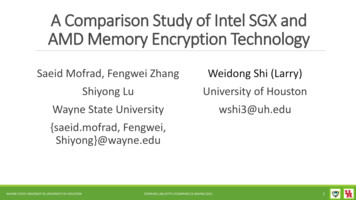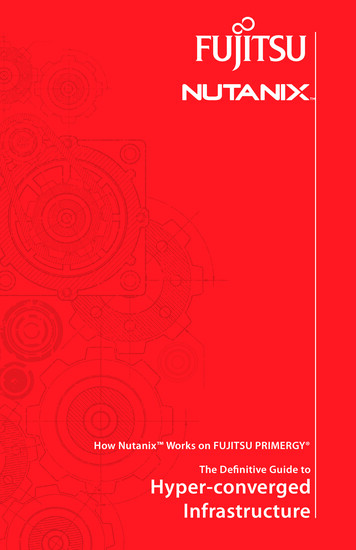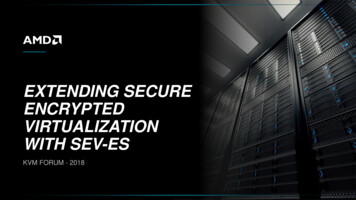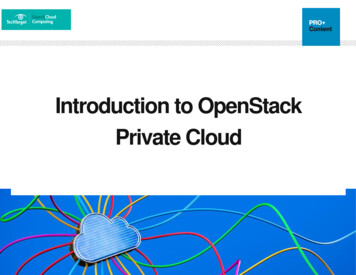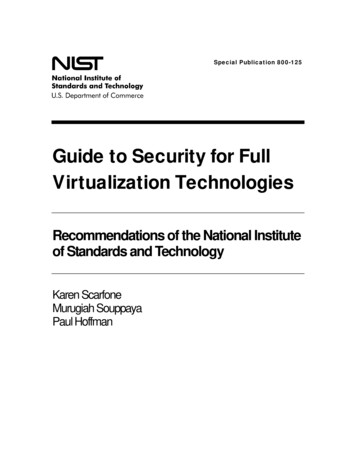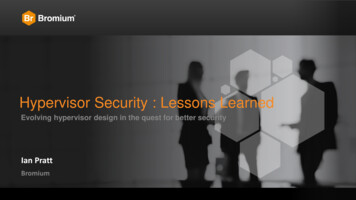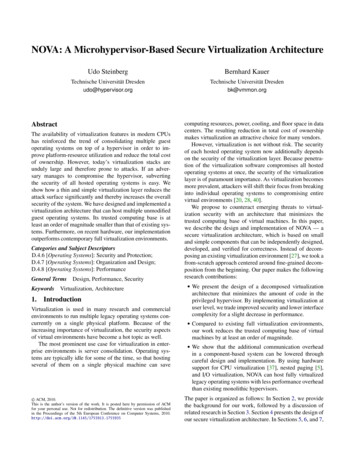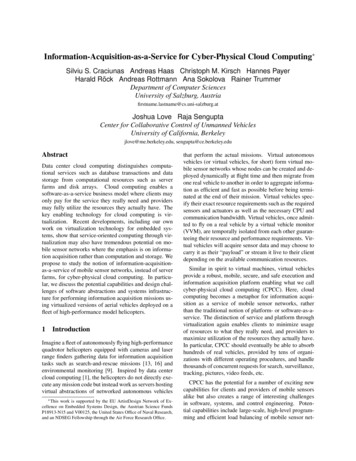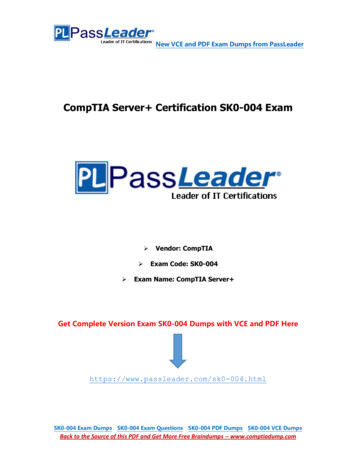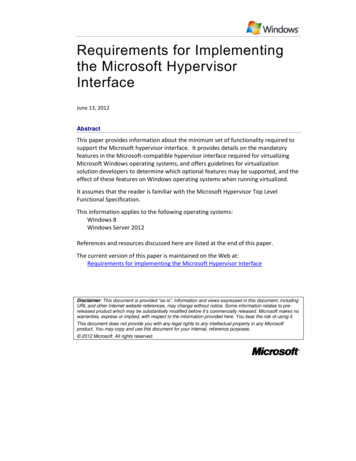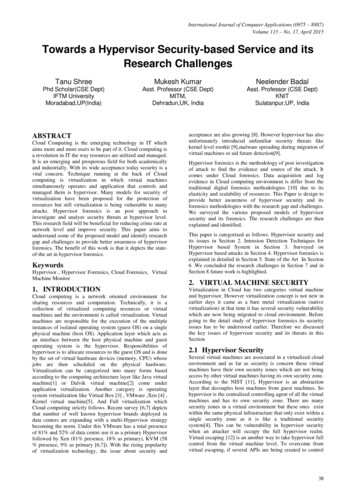
Transcription
International Journal of Computer Applications (0975 – 8887)Volume 115 – No. 17, April 2015Towards a Hypervisor Security-based Service and itsResearch ChallengesTanu ShreeMukesh KumarNeelender BadalPhd Scholar(CSE Dept)IFTM UniversityMoradabad,UP(India)Asst. Professor (CSE Dept)MITM,Dehradun,UK, IndiaAsst. Professor (CSE Dept)KNITSulatanpur,UP, IndiaABSTRACTCloud Computing is the emerging technology in IT whichaims more and more users to be part of it. Cloud computing isa revolution in IT the way resources are utilized and managed.It is an emerging and prosperous field for both academicallyand industrially. With its wide acceptance today security is avital concern. Technique running at the back of Cloudcomputing is virtualization in which virtual machinessimultaneously operates and application that controls andmanaged them is hypervisor. Many models for security ofvirtualization have been proposed for the protection ofresources but still virtualization is being vulnerable to manyattacks. Hypervisor forensics is an post approach toinvestigate and analyze security threats at hypervisor level.This research field will be beneficial for reducing crime rate atnetwork level and improve security. This paper aims tounderstand some of the proposed model and identify researchgap and challenges to provide better awareness of hypervisorforensics. The benefit of this work is that it depicts the stateof-the art in hypervisor forensics.KeywordsHypervisor , Hypervisor Forensics, Cloud Forensics, VirtualMachine Monitor1. INTRODUCTIONCloud computing is a network oriented environment forsharing resources and computation. Technically, it is acollection of virtualized computing resources or virtualmachines and the environment is called virtualization. Virtualmachines are responsible for the execution of the multipleinstances of isolated operating system (guest OS) on a singlephysical machine (host OS). Application layer which acts asan interface between the host physical machine and guestoperating system is the hypervisor. Responsibilities ofhypervisor is to allocate resources to the guest OS and is doneby the set of virtual hardware devices (memory, CPU) whosejobs are then scheduled on the physical hardware.Virtualization can be categorized into many forms basedaccording to the computing architecture layer like Java virtualmachine[1] or Dalvik virtual machine[2] come underapplication virtualization. Another category is operatingsystem virtualization like Virtual Box [3] , VMware ,Xen [4] ,Kernel virtual machine[5]. And Full virtualization whichCloud computing strictly follows. Recent survey [6,7] depictsthat number of well known hypervisor brands deployed indata centers are expanding with a multi-Hypervisor strategybecoming the norm. Under this VMware has a total presenceof 81% and 52% of data centre use it as a primary Hypervisorfollowed by Xen (81% presence, 18% as primary), KVM (58% presence, 9% as primary [6,7]). With the rising popularityof virtualization technology, the issue about security andacceptance are also growing [8]. However hypervisor has alsounfortunately introduced unfamiliar security threats likekernel level rootkit [9],malware spreading during migration ofvirtual machines or aid future detection[9].Hypervisor forensics is the methodology of post investigationof attack to find the evidence and source of the attack. Itcomes under Cloud forensics. Data acquisition and logevidence in Cloud computing environment is differ from thetraditional digital forensics methodologies [10] due to itselasticity and scalability of resources. This Paper is design toprovide better awareness of hypervisor security and itsforensics methodologies with the research gap and challenges.We surveyed the various proposed models of hypervisorsecurity and its forensics. The research challenges are thenexplained and identified.This paper is categorized as follows. Hypervisor security andits issues in Section 2. Intrusion Detection Techniques forHypervisor based System in Section 3. Surveyed onHypervisor based attacks in Section 4. Hypervisor forensics isexplained in detailed in Section 5. State of the Art In Section6 .We concluded the research challenges in Section 7 and inSection 8 future work is highlighted.2. VIRTUAL MACHINE SECURITYVirtualization in Cloud has two categories virtual machineand hypervisor. However virtualization concept is not new inearlier days it came as a bare metal virtualization (nativevirtualization) at that time it has several security vulnerabilitywhich are now being migrated to cloud environment. Beforegoing to the detail study of hypervisor forensics its securityissues has to be understood earlier. Therefore we discussedthe key issues of hypervisor security and its threats in thisSection2.1 Hypervisor SecuritySeveral virtual machines are associated in a virtualized cloudenvironment and as far as security is concern these virtualmachines have their own security zones which are not beingaccess by other virtual machines having its own security zone.According to the NIST [11], Hypervisor is an abstractionlayer that decouples host machines from guest machines. Sohypervisor is the centralized controlling agent of all the virtualmachines and has its own security zone. There are manysecurity zones in a virtual environment but these ones existwithin the same physical infrastructure that only exist within asingle security zone as it is like a traditional securitysystem[4]. This can be vulnerability in hypervisor securitywhen an attacker will occupy the full hypervisor realm.Virtual escaping [12] is an another way to take hypervisor fullcontrol from the virtual machine level. To overcome fromvirtual escaping, if several APIs are being created to control38
International Journal of Computer Applications (0975 – 8887)Volume 115 – No. 17, April 2015and disable this operation within VMs, it will also degrade theperformance of the system. So it is a vital issue to work on.4. ATTACKS ON HYPERVISORSYSTEM2.1.1 Strength of Hypervisor-based SystemsThe Hypervisor allows users to be isolated from the otherones in a cloud environment even when they are served bysame physical resources. Apart from this secure feature thereare several attacks which can harm to the hypervisor. Ascloud is designed to provide services to all legal users andalso it also give services to users that have some maliciouspurposes. So there are some of the attack at hypervisor levelwhich are as follows:The Hypervisor is a centralized management system of virtualresources, apart from that it has the capability to secure thecloud system. So for implementing secure API’s hypervisor isthe best platform in the cloud system due to the followingreasons1.Hypervisor is on the upper layer of physicalhardware in cloud system hierarchy model. So toaccess the physical system hypervisor is the onlyway to access so security in cloud system lies athypervisor level.2.Hypervisor being an interface can perform as afirewall and will be able to prevent suspicious user’sapproaches to the share physical hardware [13].3.The Hypervisor separates the guest OS and the hostOS and physical hardware so if any attack bypassthe security of guest OS the hypervisor monitor it.4.Hypervisor is capable of network monitoring incloud environment as it acts as a controller betweenthe guest OS and shared physical hardware [13].2.1.2 Weakness of Hypervisor-based Systems1.Single point-of-failure is the vital issue in thehypervisor system as only single hardware managesall the shared hardware resources in the cloudenvironment. Reason of failure can be anysuccessful attack (rootkit, DDos, Flooding attacketc) or overloading in the hypervisor which willaffect the VMs and shared hardware devices.2.Hypervisor has more security risks from wrappingattacks which performs the duplication of user-nameand password between web browser and cloudserver [14]. We will discuss this attack in the nextsection3. CONVENTIONAL INTRUSIONDETECTION TECHNIQUES FORHYPERVISOR BASED SYSTEMThe hypervisor controls the translation between the VMs andshared hardware resources. So IDSs can beuse inhypervisor as it can detect and analyze the attacks efficientlythan the same IDSs performing on the guest OS because itcannot monitor events in Cloud only it can be within its VM.However if cloud provider performs the features only then itis possible for guest OS to monitor cloud events [15]. In cloudenvironment IDSs can be used in the form of Host Intrusiondetection systems HIDS [23] and Network Intrusion Detectionsystems NIDS[22]. However there are some attacks whichonly meant for IDSs and if the attacks succeed the entirecloud system is in threat because all the relevant informationthen be access by the attacker which the NIDS has gatheredcontaining sensitive data of cloud user’s. So encryptionmethods to prevent access data is prefer by cloud user’s . As aresult NIDS can’t examine the information due to theencryption so it can become less efficient. So if the attackerand victim is in the same cloud NIDS can’t be able to probe it.May be NIDS be the best solution in hypervisor but one majorproblem is that it can’t be used for monitoring encrypted data.Wrapping Attack : This type of attack can be a threat tohypervisor in virtual environment. When a usermakes arequest to the web browser from his/her virtual machine amessage called SOAP( Simple Object Access Protocol) isgenerated. This attack with the cross site scripting thenduplicates the authentic user account and password duringlogin phase so that attacker can affect the SOAP messagesthat are exchanged during setup time of web browser and webserver.Data Stealing: Security threats at hypervisor in virtualizationsystem are the data stealing by authorized administratorwithout leaving the trace of any volume of data. To overcomefrom this problem login in hypervisor as an administratorcreate some data replication schemes by applying somepolicies like RAID and mount the disk image onto thehypervisor and deletes the original copy and lost[17].D-dos Attacks: D-Dos attacks typically works on theflooding of IP packets at specific network for the purpose ofdamaging the computer system resources. In cloudenvironment D-Dos attacks has a greater potential to disruptthe cloud infrastructure having the large amount of VM’s andits controller called hypervisor. If a hypervisor doesn’tprovide sufficient resources for its VM’s then chances ofaffecting the system by D-Dos increases. But problem ariseswhen a user inside a cloud does a botnet type D-Dos attack.Client to Client Attacks: In Cloud environment a virtualmachine having malicious characteristic could infect all thevirtual machines in the same environment. The biggestsecurity risk in a virtualized environment is when a virtualmachine having malicious feature could infect all existingvirtual machines in the same realm. In this type of attack theattacker acquire administrator authorization at infrastructurelevel and through that puts malicious content from one VMwhich then lead to disrupt other VM’s and from thereescaping the hypervisor and accessing the cloud environmentwhich can be accessible from VM level. Hence major risks inthe hypervisor and virtualized environment are client levelattacks. SQL injection[18], spoofing attacks[19] are some ofthe examples.Vulnerable Interfaces and Api’s: In cloud environment, thecloud service provider (CSP) releases software interfaces orAPI’s even for hypervisor upgradation software patches havebeen used for smoothly working at infrastructure level. Sovulnerable interfaces and API’s can lead to the security issuesof confidentiality, availability and data integrity [19] athypervisor level.5. HYPERVISOR FORENSICSForensics is defined as applying proven methodology forcollecting of evidences and analysis of a crime scene. Here issome forensics realm in IT.39
International Journal of Computer Applications (0975 – 8887)Volume 115 – No. 17, April 20155.1 Digital ForensicsDigital forensics is defined as proven methodology towardsthe collection, identification, validation, andanalysis ofdigital data logs for the purpose of further criminalinvestigation [20].5.2 Network ForensicsNetwork Forensics [21] is a subclass of digital forensicsrelating to the monitoring and analysis of network traffic forthe purpose of crucial information collection authenticevidence or intrusion detection[19]. Its main function is toanalyze the data from network traffic by capturing of packetsthrough firewalls , intrusion detection system or devices likerouters[22]. Some popular network forensics tools arewireshark[21] , snort[21], TCP dump[21] , and many more.According to e.s pilli[21] , network forensics follows the stepsof preparation, detection, incident response, collection,examination, investigation and presentation.5.3 Cloud ForensicsCloud Forensics is the sub branch of network forensics .Ascloud runs on a network and all its equipments like networkdevices like (hubs or switches) or applications like hypervisorare also works in network forensics platform. Cloud Forensicsinvolves collecting crucial information from cloud for thepurpose of investigation [24].5.4 Hypervisor ForensicsHypervisor (Virtual Machine Manager or “VMM”) is anabstraction layer between guest OS and physical devices , soall data that has to be processed from guest OS has to be passthrough hypervisor before physical devices (e.g. CPU, NIC.)assessment. The use of this data at hypervisor can be used as alog evidence for hypervisor forensics.”Virtual machineintrospection (VMM)” terminology is generally used inHypervisor based forensics. And that data must be used inintrusion detection purposes. As far as there is theaccessibility to the hypervisor it will be suitable forinvestigating in cloud environment.6. STATE-OF-THE ARTIn this section, after going through a literature survey wepresent the state-of-the art in hypervisor forensics in threecategories. Forensics methodology on various knownhypervisor, research gap and challenges.6.1 Forensics Methodology on variousknown HypervisorIn this section we have explained different approaches ofHypervisor forensics in common hypervisors6.1.1 XENXen [4] is a popular Para virtualized system under this aLibVMI framework runs under DOM0 region for the purposeof direct memory access of virtualized hardware. Xen mainfunction is to translate specific address which is generated byan application in DOM0 region into physical address. Thisaddress then reverts back into DOM0 address space. So datastructure generated by that pointer is the process ID offset,executable name offset. To acquire all information about eachapplication processes useful memory addresses have to bemapped in between DOM0 and DOMU address region. Eachentry of the process in the list has to be mapped from memoryregion of DOM0 [24]. This procedure comes under virtualmachine introspection and LibVMI allows investigation toaccess information about process .However memory mappingprocedure is hidden for users of programming library.6.1.2 KVMKernel virtual machine (KVM) [5] is an open source projectfor Linux X86 platform that works on full virtualizationconcepts. Here in this virtual machine whole management ofvirtual hardware allocation is done by QEMO [25]. However,LibVMI [25] also offers features to obtain forensicallymemory dumps . Patches are available to only for (QEMUKVM 0.14.0). Also “KVMsec” [83] project is introduced toincrease the security of guest VM against malware androotkits attacks. Its main feature is that it can collect crucialdata on guest machine. It provides two-way security between the host andguest in virtual environment. It works well against malicious virtual machine.Major advantages of this project that it comprises ofmultiple modules working in host and guest kernellevel.6.1.3 VMware ESXiGarfinkel and Roesenblum[26] proposed a VMI-basedIntrusion detection system(IDS) called Livewire. Thisprototype is designed for upgrading VMware workstation onLinux X86 platform to gain access to memory CPU registers.Another security solution for VMware is introduced in 2008name VMsafe program[85]. It provides some unique featuresi.e it provides some API’s programs that enables thedeveloper to develop some security product for vmware.Vmsafe provides some third party API’s which get into theoperation with hypervisor to analyze and eliminate virus,Trojans, key loggers , or any rootkit attacks. Also Cloudsecproject [27] a research agreement between Telenor andSINTEF has develop a security aspects that any organizationshould consider when dealing with cloud services. Cloudsecprovides access to physical memory of VMs through VmsafeAPI’s. It is not mandatory to install security inside VMs In theframework low-level information (bytes) is mapped into highlevel data structures that allows the detection of Dynamickernel object manipulation (DKOM) and Kernel objecthooking (KOH) root kits. Thus the approach corresponds tothe out-of-band delivery model.7. RESEARCH CHALLENGES INHYPERVISOR FORENSICSBy analysis of digital and cloud computing forensicsinvestigation studies it is obvious that nature of hypervisor isin contrast as compare to digital forensics. None of theapplication and framework for digital data collection isfeasible in cloud and hypervisor models. On the basis ofdigital study in forensics methodology in digital environmentthe following problems are identified. In this section we areon a deep look of the issues that investigators should face.7.1 IdentificationCloud has a distributed environment so at hypervisor levelidentification of feasible sources of evidences is a tedioustask. Accessing the log evidences is the first issue inidentification stage which consists of checking system statusand log file. However, this is not possible in hypervisor levelbecause client is limited to the API’s. At IaaS level it islimited partly applicable. At hypervisor level data loss involatile storage is a challenge of forensic investigation. Wherethere is no evidence. Such volatile data storage policy in40
International Journal of Computer Applications (0975 – 8887)Volume 115 – No. 17, April 2015virtual environment may lead to loss of evidences in a casewhen a criminal force to power off the machine [28].[5] Linux,(2014), “KVM 4.2 “, [online].http://www.linux-kvm.org, [Oct, 15, 2014]7.2 Collection[6] p/nexenta-hypervisorsurvey.Collecting evidences is the main issue in computer forensicsinvestigation and it is not completely possible to in distributedcomputing environment i.e. cloud computing. Computerforensics works with seizing the evidences from physicaldevices. And due to the virtual environment of the cloudcollection of log evidences is a difficult task. However, inIaaS system using the snap-shot of VMs can hold to pause thestatus and investigate the system [29, 30].7.3 PreservationEvidence is the only proof of some criminal activities and anycrime to the trustworthy or relation of the evidence makes itof no use. So preserving the evidences is another issue inforensics investigation.7.4 AnalysisAnalysis of data is also an essential setup of cloud andhypervisor forensics. Especially in cloud system where itrequired more attentive examination of objects and logevidences at wide level. This is an additional issue ofhypervisor forensics due to the limitation in log evidenceprocessing [31].7.5 ReportingReporting is the last step of forensics investigation athypervisor level. In computer forensics it is not difficult todecide the court and the case would be brought in the country.But when it comes of distributed network or wide virtualenvironment it is more complicated issue related to the crimelocation, physical availability as cloud resources are sharedbetween multiple Countries and different locations. Thistypically confuse investigators to decide about the legalsystem [31].8. CONCLUSION AND FUTURE WORKThis paper presents the state-of-the art in hypervisor forensicsafter defining hypervisor security and differentiating it withdigital forensics, network forensic and cloud forensics. Someof the phases are also discussed which comes under forensicsinvestigation in cloud environment. There is a greatrequirement for updating digital forensic investigationmethodology as updating of technologies in today’s era willmake it of no use. Research challenges describe in this paperare surveyed and listed with issues. As development ofhypervisor forensics is in initial stage we hope our researchwork will provide better understating of techniques andchallenges of hypervisor forensics.We will proposesome framework for hypervisor forensics having all thephases cover with some respective tools for each phases infuture work.9. REFERENCES[1] Java virtual machine, (2014), [online]. Available:http://en.wikipedia.org/wiki, [Oct,17,2014].[2] Dalvik virtual machine, (2014),[online]. Available:http://en.wikipedia.org/wiki, [Oct, 18, 2014].[3] Sun-Oracle,(2014), “ Virtual Box 8.2”, [online].Available: http://www.virtualbox.org, [Oct, 16, 2014][4] Xen,(2014),[online].http://www.xenproject.org, [Oct, 21, 2014]Available:Available:[7] or-server-virtualization.aspx.[8] vuln/search.database.[9] J. Levine, J. Grizzard, and H. Owen. Detecting andcategorizing kernel-level rootkits to aid future detection.IEEE Security Privacy Magazine, 4(1):24 {32, January{February 2006}[10] Heiser J. Remote forensics software. Gartner RAS coreResearch Note G00171898; 2011.[11] National Institute of Standards and pdeia.org/wiki,[Oct,20,2014]/[12] Virtual machine escape, (2014), [online] Available:http:// en.wikidpedia.org/wiki, [Oct, 20,2014][13] .T. Ristenpart and e. al, "Hey, you, get off of my cloud:exploring information leakage in third-party computeclouds," presented at the16th ACM conference onComputer and communications security, Chicago, IL,November 9-13, 2009.[14] "Securing Virtualization in Real-World Environments,"White paper, 2009.Rosenblum M. and Garfinkel T.Virtual machine monitors: current technology and futuretrends. Computer, 38(5):39–47, May 2005.[15] Renato J. Figueiredo, Peter A. Dinda, and J. Fortes. Acase for grid computing on virtual machines. In ICDCS’03: Proceedings of the 23rd International Conference onDistributed Computing Systems, page 550, Washington,DC, USA, 2003. IEEE Computer Society.[16] J. Mutch, (2010), "How to Steal Data from oud, [Oct. 15,2014][17] ikipedia.org/wiki, [Nov, 02, 2014].[18] ww.veracode.com/security/spoofingattack, [Nov,01,2014][19] N. L. Beebe and J. G. Clark, "A hierarchical, objectivesbased framework for the digital investigations process,"Digital Investigation, vol. 2, no. 2, pp. 147-167, 2005.[20] E. S. Pilli, R. C. Joshi, and R. Niyogi, "Network forensicframeworks: Survey and Research Challenges," DigitalInvestigation, vol. 7, no. 1/2, pp. 14-27, 2010.[21] Network Intrusion Detection Systems [Online]Available: http://wikipedia.org/ [Nov,04,2014][22] Host Intrusion Detection Systems [Online] Available:http://wikipedia.org/ [Nov,04,2014][23] t.citrix.com/article/CTX126531[Nov,08,2014]41
International Journal of Computer Applications (0975 – 8887)Volume 115 – No. 17, April 2015[24] .com/p/vmitools/wiki/LibVMIIntrodution [Nov,10,2014].[25] M. Rosenblum, E. Garfinkel, S. Devine, and S. A. Herrod. Using the simos machine simulator to study complexcomputer systems. Modeling and Computer Simulation,7(1):78–103, 1997.[26] om/[Nov,21,2014].Available:[27] Cheng Yan, “Cybercrime forensic system in cloudcomputing”, Image Analysis and Signal Processing(IASP), 2011 International Conference on , vol., no.,IJCATM : rnumber 6109117[28] Patrick, (2010), "Security in a Public IaaS Cloud Part sigma.com/blog/15-security-in-thecloud-data- storage, [Oct. 15, 2014].[29] F. Xinwen, L. Zhen, Y. Wei, and L. Junzhou, "CyberCrime Scene Investigations (C2;SI) through CloudComputing," in IEEE 30th International Conference onDistributed Computing Systems Workshops (ICDCSW),2010, 2010, pp. 26-31.42
Hypervisor , Hypervisor Forensics, Cloud Forensics, Virtual Machine Monitor 1. INTRODUCTION Cloud computing is a network oriented environment for sharing resources and computation. Technically, it is a collection of virtualized computing resources or virtual machines and the environment is called virtualization. Virtual
